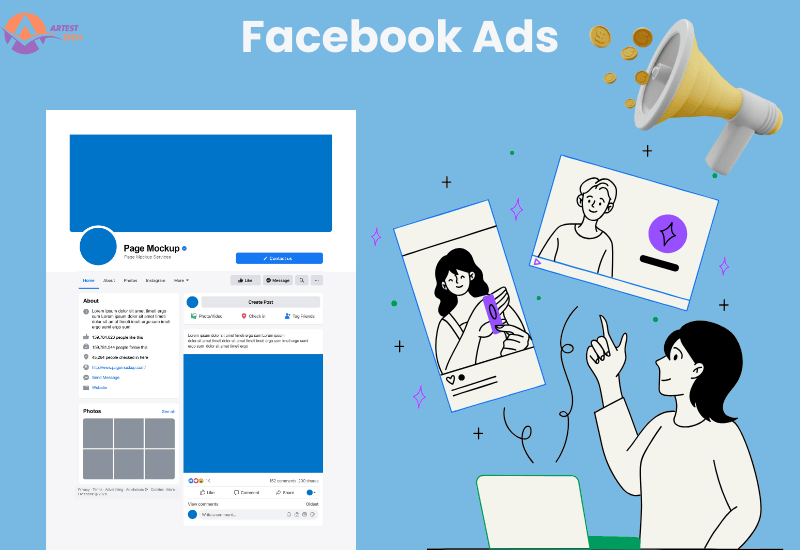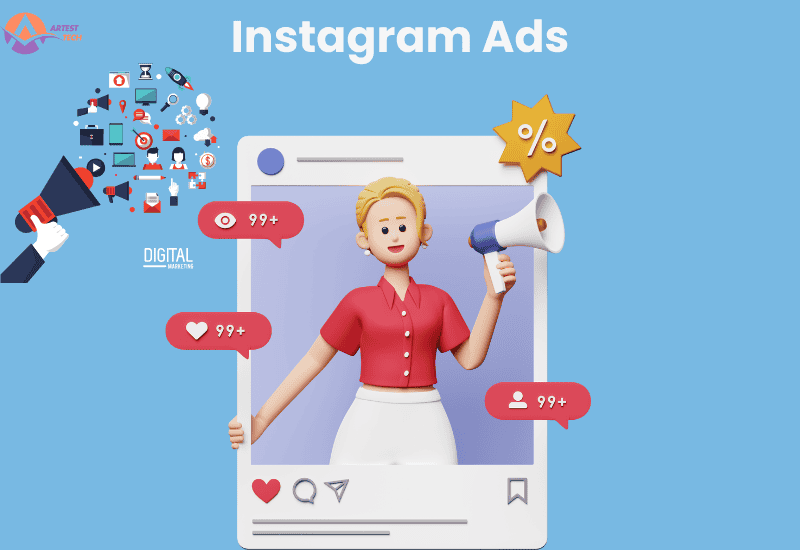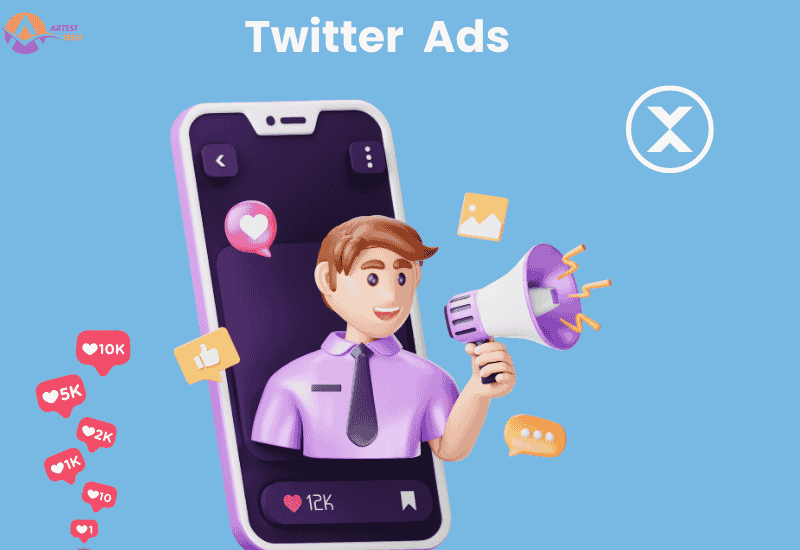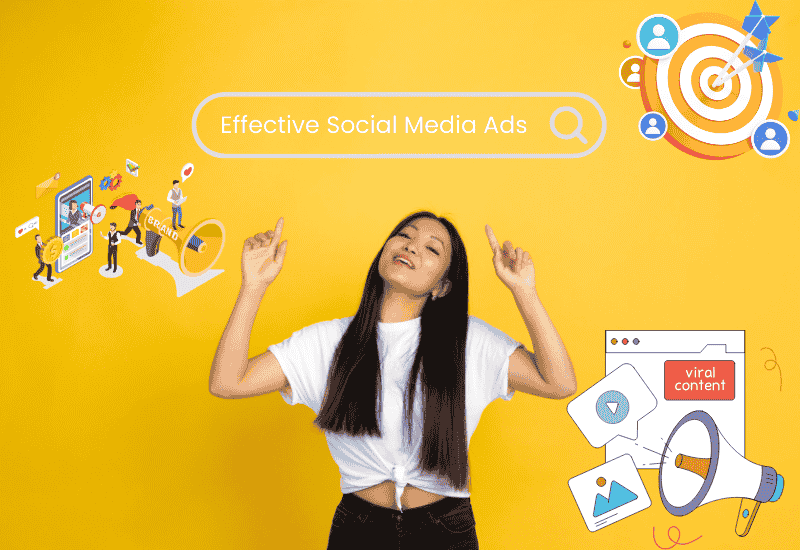
What is Social Media Advertising?
Introduction to Social Media Advertising
Social media advertising is a powerful tool for businesses to reach targeted audiences and drive engagement. By leveraging platforms like Facebook, Instagram, and LinkedIn, companies can create ads tailored to specific demographics, interests, and behaviors. These ads increase brand visibility, generate traffic, and boost conversions, making them essential for modern marketing strategies.
With the rapid growth of social media, advertising on these platforms has become an integral part of digital marketing. Social media ads allow businesses to track performance in real-time, optimizing campaigns for better results. As a result, businesses can achieve measurable growth, improve customer acquisition, and maintain a competitive edge in their industry.
Why Social Media Advertising is Important for Businesses?
Social media advertising is crucial for businesses as it helps increase brand visibility, drive targeted traffic, and boost conversions. By utilizing platforms like Facebook, Instagram, and LinkedIn, companies can reach specific audiences based on demographics and interests. Moreover, social media ads allow businesses to track real-time performance, optimize campaigns, and achieve measurable results. Therefore, investing in social media advertising enables businesses to stay competitive, build brand awareness, and foster customer loyalty.
The Growth and Evolution of Social Media Advertising
The growth and evolution of social media advertising have transformed digital marketing strategies, enabling businesses to reach highly targeted audiences. Initially, social media platforms offered basic advertising options, but over time, advanced targeting features, like behavioral and interest-based targeting, were introduced. As user engagement increased, social media ads became more sophisticated, including options like video ads and stories. Today, social media advertising continues to evolve with innovations like AI-powered targeting and interactive ad formats. Consequently, businesses can now achieve more personalized and impactful campaigns, driving greater results and ROI.
How Social Media Advertising Works?
Social media advertising works by allowing businesses to create paid ads that target specific audiences based on demographics, interests, and behaviors. These ads appear on platforms like Facebook, Instagram, LinkedIn, and Twitter, and can take various forms such as images, videos, carousels, or stories. By setting clear objectives like brand awareness, lead generation, or conversions, businesses can optimize their campaigns for better results.
Through detailed analytics, businesses can monitor ad performance, adjust targeting, and refine their strategies for improved ROI. Social media platforms provide tools for tracking metrics such as clicks, impressions, and conversions, which help measure the effectiveness of each campaign. Consequently, businesses can continuously optimize their ads to achieve their marketing goals and maximize engagement.
Paid vs. Organic Social Media Marketing
Paid social media marketing involves creating ads to reach targeted audiences quickly, while organic social media marketing focuses on engaging audiences through non-paid content. Paid ads provide immediate results, offering precise targeting options, whereas organic strategies build long-term relationships and brand trust. Both approaches complement each other, as paid campaigns can boost organic content reach, and organic efforts enhance ad performance by increasing engagement. Therefore, combining both strategies is essential for maximizing overall social media marketing effectiveness.
Overview of Ad Campaign Objectives (Brand Awareness, Lead Generation, Conversions)
Ad campaign objectives like brand awareness, lead generation, and conversions focus on different marketing goals. Brand awareness campaigns aim to increase visibility, while lead generation ads gather customer data for future engagement. Conversion-focused campaigns drive specific actions, such as purchases or sign-ups. By aligning objectives with business goals, advertisers can optimize campaigns for better results. Consequently, selecting the right objective ensures higher ROI and more effective ad performance.
Types of Social Media Ads (Image, Video, Carousel, etc.)
Social media ads come in various formats, including image, video, carousel, and slideshow ads. Image ads are simple and effective for visual storytelling, while video ads engage users with dynamic content. Carousel ads allow multiple images or videos in a single ad, offering interactive experiences. By selecting the right ad type, businesses can tailor campaigns to their audience, improving engagement and conversion rates. Therefore, understanding each ad format’s strengths helps optimize social media advertising strategies.
Popular Social Media Platforms for Advertising
Social media advertising is essential for businesses to reach targeted audiences. Platforms like Facebook, Instagram, Twitter, and LinkedIn offer unique features to enhance ad campaigns. Facebook Ads allow precise targeting based on user data, while Instagram Ads are highly visual, making them ideal for brand-building. LinkedIn Ads excel in B2B marketing, targeting professionals with advanced segmentation options.
In addition, platforms like TikTok and YouTube provide opportunities for video-based advertising, engaging users with dynamic content. TikTok Ads are effective for reaching younger audiences, while YouTube Ads allow businesses to showcase their products in video format. By choosing the right platform, businesses can optimize their advertising strategies for greater engagement and better results.

Facebook Ads
Facebook Ads allow businesses to target specific audiences with highly customizable ad formats, boosting engagement, brand awareness, and conversions. By leveraging Facebook’s advanced targeting options, businesses can reach users based on demographics, interests, and behaviors. Moreover, Facebook Ads offer various formats, such as image, video, and carousel ads, making it easier to create engaging content. As a result, businesses can improve their ROI and achieve measurable campaign success. Therefore, Facebook Ads are essential for driving traffic and increasing conversions effectively.

Instagram Ads
Instagram Ads offer visually engaging formats that help businesses reach a targeted audience, increase brand awareness, and drive conversions. By using Instagram’s advanced targeting features, businesses can effectively engage with users based on demographics, interests, and behaviors. These ads, including photo, video, and carousel options, allow brands to showcase products in creative ways. Consequently, Instagram Ads drive higher engagement and stronger customer connections, making them a powerful tool for businesses seeking to enhance their online presence

Twitter Ads
Twitter Ads enable businesses to target specific audiences through promoted tweets, increasing brand visibility, engagement, and driving conversions. By utilizing Twitter’s precise targeting options, businesses can reach users based on interests, demographics, and behaviors. These ads, including image, video, and carousel formats, encourage interaction and drive website traffic. As a result, Twitter Ads offer measurable results, making them essential for businesses looking to enhance their online presence. Therefore, Twitter Ads are a key tool for effective social media marketing.

Youtube Ads
YouTube Ads allow businesses to reach a vast audience with engaging video content, increasing brand awareness and driving conversions. By targeting users based on interests, demographics, and behaviors, YouTube Ads ensure that your message reaches the right viewers. With options like skippable and non-skippable ads, businesses can effectively showcase products or services. Consequently, YouTube Ads provide measurable results, making them a powerful tool for driving traffic and boosting brand engagement. Therefore, leveraging YouTube Ads enhances any digital marketing strategy.

Creating Effective Social Media Ads
Creating effective social media ads involves understanding your target audience and crafting compelling, engaging content. By using attention-grabbing visuals, clear messaging, and strong calls-to-action (CTAs), businesses can drive higher engagement and conversions. Additionally, selecting the right ad format, whether image, video, or carousel, ensures that the message resonates with users.
Optimizing social media ads is essential for success. Testing different ad creatives, targeting options, and budgets allows you to fine-tune campaigns for better performance. As a result, you can achieve higher ROI and more effective ad results. Therefore, creating well-targeted, visually appealing ads is crucial for improving your social media advertising efforts.
Targeting and Audience Segmentation
Targeting and audience segmentation are essential for creating effective social media ads that reach the right people. By analyzing demographics, interests, behaviors, and location, businesses can ensure their ads are shown to those most likely to engage. This increases the chances of driving traffic, generating leads, and improving conversion rates.
Moreover, using custom and lookalike audiences allows advertisers to further refine their campaigns. Retargeting also helps reach users who previously interacted with your brand, keeping your business top-of-mind. Consequently, proper targeting and segmentation maximize ad effectiveness and boost overall ROI. Therefore, audience segmentation is a key factor in successful social media advertising.
Setting Your Budget for Social Media Ads
Setting your budget for social media ads involves determining a cost-effective strategy that aligns with campaign goals. By choosing between daily or lifetime budgets, businesses can control spending and maximize ROI. Additionally, selecting the right bidding strategy (CPC, CPM, CPA) helps optimize ad performance. Consequently, a well-planned budget ensures efficient use of resources, driving better results and maintaining cost-effectiveness in social media advertising.
Running Your First Social Media Ad Campaign
Running your first social media ad campaign involves setting clear objectives, choosing the right platform, and defining your target audience. By selecting an appropriate ad format and budget, you can effectively reach potential customers. Additionally, monitoring performance and making adjustments ensures optimal results. As a result, running a successful campaign helps increase brand visibility and drive conversions. Therefore, a well-executed ad campaign is essential for achieving marketing goals
Analyzing and Measuring Social Media Ad Performance
Analyzing and measuring social media ad performance involves tracking key metrics like CTR, CPC, and conversion rates. By using analytics tools provided by platforms like Facebook Ads Manager or Google Analytics, businesses can evaluate how well their campaigns are performing. This data helps identify which ads resonate with the target audience and where adjustments are needed.
Moreover, regularly reviewing ad performance allows businesses to optimize targeting, ad creatives, and budgets for better results. As a result, making data-driven decisions ensures continuous improvement and maximizes ROI. Therefore, analyzing and measuring performance is essential for running successful social media ad campaigns.
Best Practices for Social Media Advertising
Best practices for social media advertising involve creating clear objectives and targeting the right audience. By understanding your audience’s demographics, interests, and behaviors, you can deliver highly relevant and engaging ads. Moreover, using the right ad format, such as images, videos, or carousels, ensures that your message resonates effectively with users.
Another best practice is to test and optimize your campaigns regularly. A/B testing different ad creatives, copy, and targeting options allows you to identify what works best. This helps refine your strategy for improved results and ensures that your ad budget is spent efficiently.
Finally, monitoring ad performance is crucial for continuous improvement. By analyzing key metrics such as click-through rates (CTR) and conversion rates, you can make data-driven adjustments. As a result, these best practices lead to higher engagement, better ROI, and more successful social media advertising campaigns. Therefore, implementing these strategies is vital for maximizing the effectiveness of your ads.
Social Media Advertising Trends
Social media advertising trends are constantly evolving, with video content and stories becoming increasingly popular. As users engage more with short-form video ads, platforms like Instagram, Facebook, and TikTok are prioritizing these formats. Consequently, businesses are shifting their focus to create dynamic and engaging video content that resonates with their audience.
Additionally, the rise of social commerce is a major trend, allowing users to purchase products directly through ads on social media platforms. With more users shopping online, integrating shopping features into ads has become essential for businesses. As a result, leveraging these trends helps improve user engagement, drive sales, and ensure a competitive edge in the social media advertising landscape. Therefore, staying updated with emerging trends is crucial for successful campaigns
Common Mistakes to Avoid in Social Media Advertising
One common mistake in social media advertising is failing to define clear campaign objectives. Without clear goals, ads lack direction, leading to poor performance. Therefore, businesses should set measurable objectives like brand awareness, lead generation, or conversions to guide their campaigns effectively.
Another mistake is targeting the wrong audience. Overly broad or poorly defined audience targeting can result in wasted ad spend. By refining audience segmentation, businesses can reach the most relevant users, increasing engagement and ROI.
Additionally, neglecting to test ad creatives and formats is a mistake. A/B testing different visuals, headlines, and calls-to-action helps determine what works best. This continuous optimization ensures better ad performance and prevents wasting resources on ineffective content.
Lastly, ignoring performance metrics is a critical error. Analyzing key metrics like CTR, CPC, and conversions allows businesses to adjust campaigns for maximum impact. Regular performance reviews lead to more successful and cost-effective social media ad strategies.
Conclusion
In conclusion, social media advertising is a powerful tool for businesses to increase visibility, drive traffic, and boost conversions. By leveraging the right platforms, targeting specific audiences, and optimizing campaigns, businesses can achieve measurable results and a strong online presence.
Therefore, implementing best practices such as defining clear objectives, testing creatives, and analyzing performance is essential for success. With continuous adaptation to trends and audience behavior, social media advertising can deliver long-term growth and a competitive edge in the market.
